Investigating Technology Use for Student Collaboration at UWTSD
VerifiedAdded on 2023/06/08
|11
|2596
|152
Report
AI Summary
This research report investigates the use of technology in student collaboration at the University of Wales Trinity Saint David (UWTSD). The study employs a quantitative research method, using a questionnaire to gather data on students' knowledge and experiences with collaboration tools like Skype, Google Hangouts, and Slack. The results indicate that a majority of students are familiar with and confident in using technology for collaboration, recognizing its importance in increasing productivity and enhancing communication. However, challenges such as a shortage of relevant resources, a lack of adequate knowledge, and ineffective training sessions are also identified. The report concludes by emphasizing the significant role of technology in facilitating student collaboration and suggests providing support and positive feedback to further enhance its effectiveness. Desklib provides similar resources for students.

Report- Research report
Paraphrase This Document
Need a fresh take? Get an instant paraphrase of this document with our AI Paraphraser
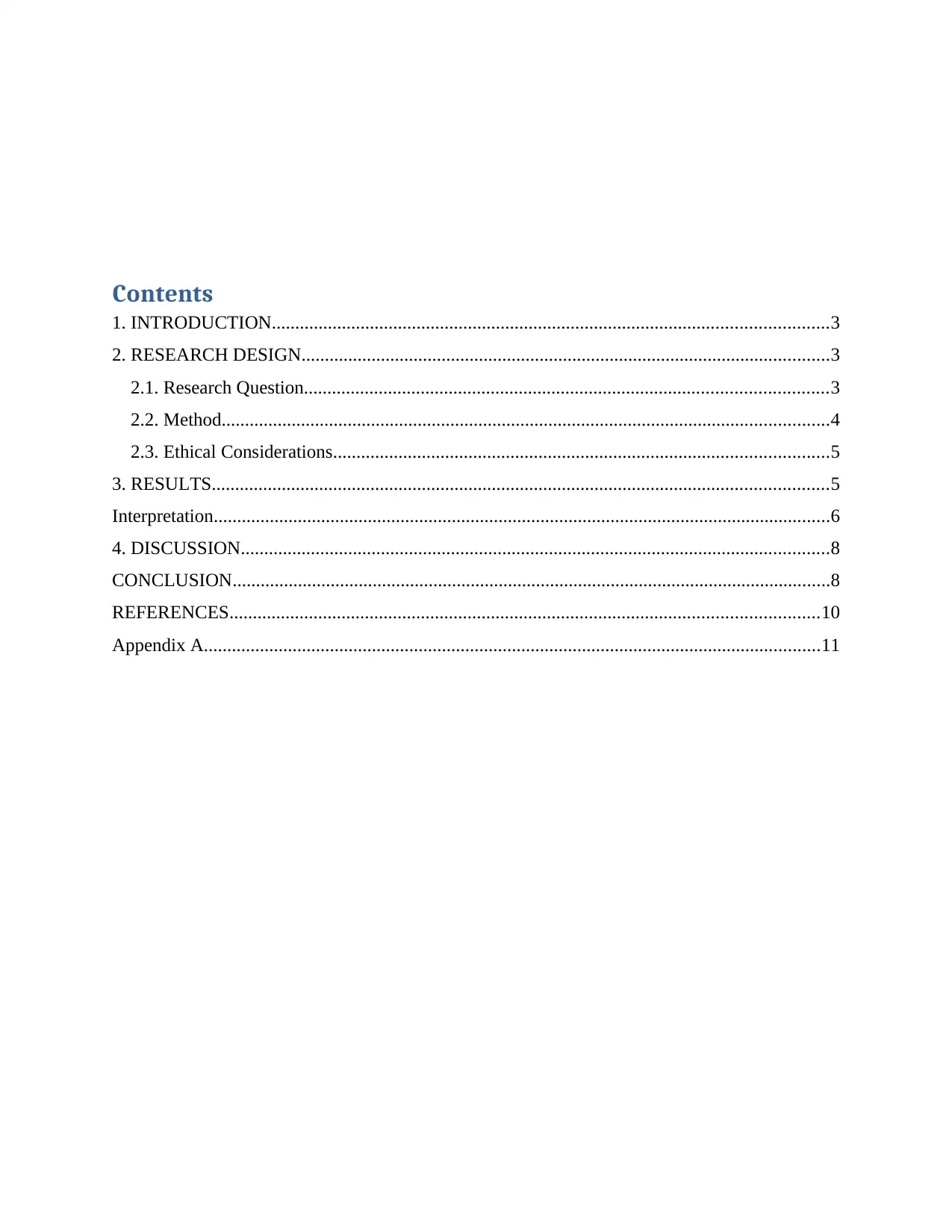
Contents
1. INTRODUCTION.......................................................................................................................3
2. RESEARCH DESIGN.................................................................................................................3
2.1. Research Question................................................................................................................3
2.2. Method..................................................................................................................................4
2.3. Ethical Considerations..........................................................................................................5
3. RESULTS....................................................................................................................................5
Interpretation....................................................................................................................................6
4. DISCUSSION..............................................................................................................................8
CONCLUSION................................................................................................................................8
REFERENCES..............................................................................................................................10
Appendix A....................................................................................................................................11
1. INTRODUCTION.......................................................................................................................3
2. RESEARCH DESIGN.................................................................................................................3
2.1. Research Question................................................................................................................3
2.2. Method..................................................................................................................................4
2.3. Ethical Considerations..........................................................................................................5
3. RESULTS....................................................................................................................................5
Interpretation....................................................................................................................................6
4. DISCUSSION..............................................................................................................................8
CONCLUSION................................................................................................................................8
REFERENCES..............................................................................................................................10
Appendix A....................................................................................................................................11
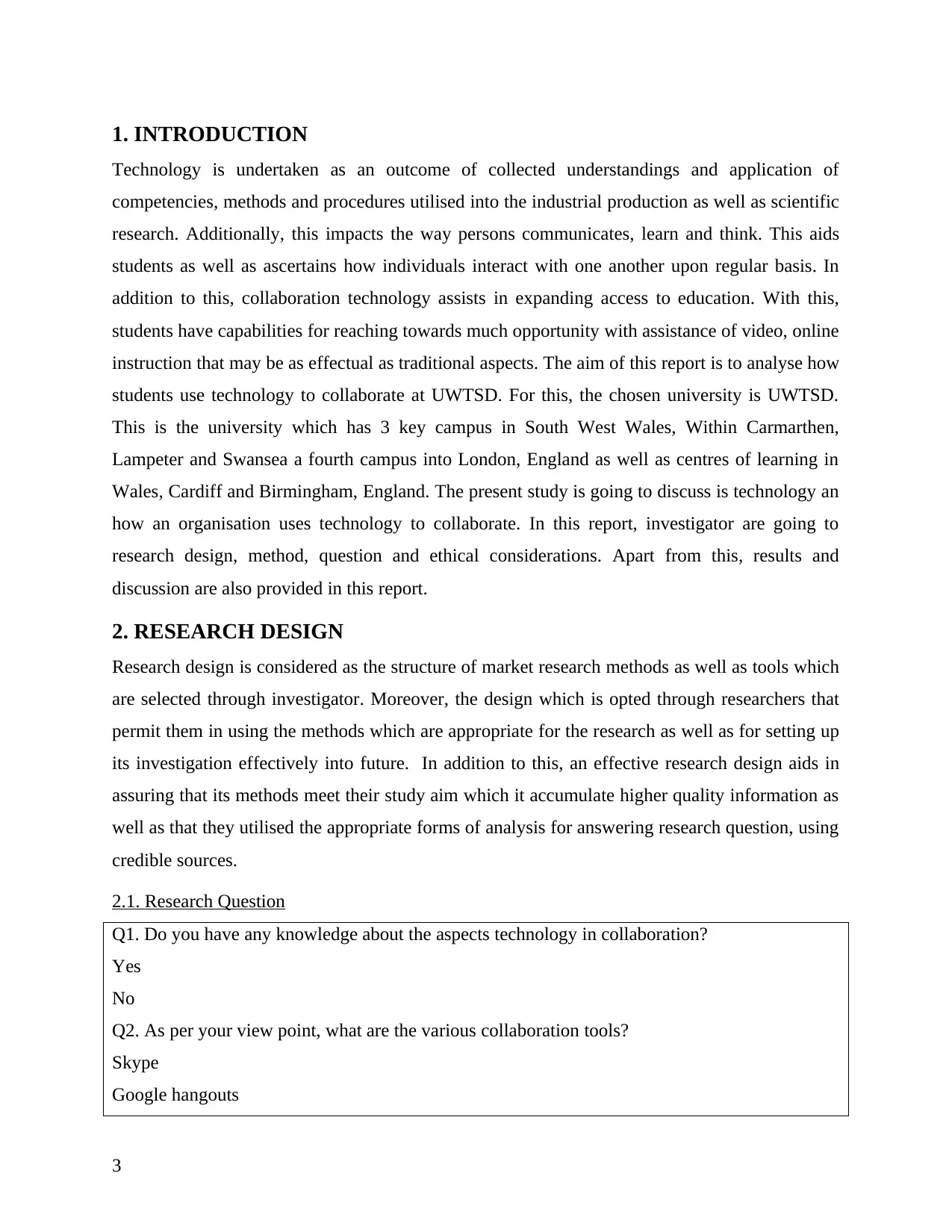
1. INTRODUCTION
Technology is undertaken as an outcome of collected understandings and application of
competencies, methods and procedures utilised into the industrial production as well as scientific
research. Additionally, this impacts the way persons communicates, learn and think. This aids
students as well as ascertains how individuals interact with one another upon regular basis. In
addition to this, collaboration technology assists in expanding access to education. With this,
students have capabilities for reaching towards much opportunity with assistance of video, online
instruction that may be as effectual as traditional aspects. The aim of this report is to analyse how
students use technology to collaborate at UWTSD. For this, the chosen university is UWTSD.
This is the university which has 3 key campus in South West Wales, Within Carmarthen,
Lampeter and Swansea a fourth campus into London, England as well as centres of learning in
Wales, Cardiff and Birmingham, England. The present study is going to discuss is technology an
how an organisation uses technology to collaborate. In this report, investigator are going to
research design, method, question and ethical considerations. Apart from this, results and
discussion are also provided in this report.
2. RESEARCH DESIGN
Research design is considered as the structure of market research methods as well as tools which
are selected through investigator. Moreover, the design which is opted through researchers that
permit them in using the methods which are appropriate for the research as well as for setting up
its investigation effectively into future. In addition to this, an effective research design aids in
assuring that its methods meet their study aim which it accumulate higher quality information as
well as that they utilised the appropriate forms of analysis for answering research question, using
credible sources.
2.1. Research Question
Q1. Do you have any knowledge about the aspects technology in collaboration?
Yes
No
Q2. As per your view point, what are the various collaboration tools?
Skype
Google hangouts
3
Technology is undertaken as an outcome of collected understandings and application of
competencies, methods and procedures utilised into the industrial production as well as scientific
research. Additionally, this impacts the way persons communicates, learn and think. This aids
students as well as ascertains how individuals interact with one another upon regular basis. In
addition to this, collaboration technology assists in expanding access to education. With this,
students have capabilities for reaching towards much opportunity with assistance of video, online
instruction that may be as effectual as traditional aspects. The aim of this report is to analyse how
students use technology to collaborate at UWTSD. For this, the chosen university is UWTSD.
This is the university which has 3 key campus in South West Wales, Within Carmarthen,
Lampeter and Swansea a fourth campus into London, England as well as centres of learning in
Wales, Cardiff and Birmingham, England. The present study is going to discuss is technology an
how an organisation uses technology to collaborate. In this report, investigator are going to
research design, method, question and ethical considerations. Apart from this, results and
discussion are also provided in this report.
2. RESEARCH DESIGN
Research design is considered as the structure of market research methods as well as tools which
are selected through investigator. Moreover, the design which is opted through researchers that
permit them in using the methods which are appropriate for the research as well as for setting up
its investigation effectively into future. In addition to this, an effective research design aids in
assuring that its methods meet their study aim which it accumulate higher quality information as
well as that they utilised the appropriate forms of analysis for answering research question, using
credible sources.
2.1. Research Question
Q1. Do you have any knowledge about the aspects technology in collaboration?
Yes
No
Q2. As per your view point, what are the various collaboration tools?
Skype
Google hangouts
3
⊘ This is a preview!⊘
Do you want full access?
Subscribe today to unlock all pages.

Trusted by 1+ million students worldwide
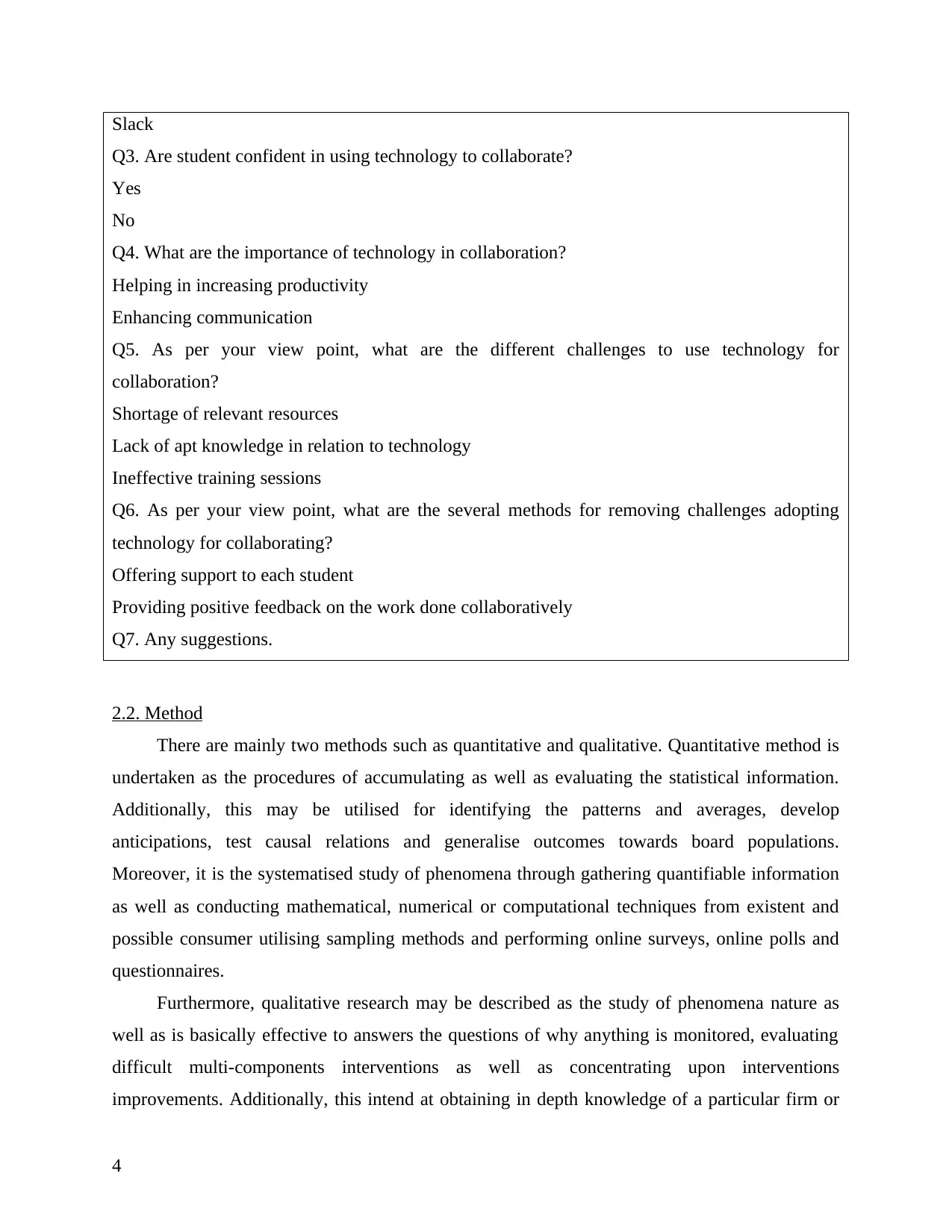
Slack
Q3. Are student confident in using technology to collaborate?
Yes
No
Q4. What are the importance of technology in collaboration?
Helping in increasing productivity
Enhancing communication
Q5. As per your view point, what are the different challenges to use technology for
collaboration?
Shortage of relevant resources
Lack of apt knowledge in relation to technology
Ineffective training sessions
Q6. As per your view point, what are the several methods for removing challenges adopting
technology for collaborating?
Offering support to each student
Providing positive feedback on the work done collaboratively
Q7. Any suggestions.
2.2. Method
There are mainly two methods such as quantitative and qualitative. Quantitative method is
undertaken as the procedures of accumulating as well as evaluating the statistical information.
Additionally, this may be utilised for identifying the patterns and averages, develop
anticipations, test causal relations and generalise outcomes towards board populations.
Moreover, it is the systematised study of phenomena through gathering quantifiable information
as well as conducting mathematical, numerical or computational techniques from existent and
possible consumer utilising sampling methods and performing online surveys, online polls and
questionnaires.
Furthermore, qualitative research may be described as the study of phenomena nature as
well as is basically effective to answers the questions of why anything is monitored, evaluating
difficult multi-components interventions as well as concentrating upon interventions
improvements. Additionally, this intend at obtaining in depth knowledge of a particular firm or
4
Q3. Are student confident in using technology to collaborate?
Yes
No
Q4. What are the importance of technology in collaboration?
Helping in increasing productivity
Enhancing communication
Q5. As per your view point, what are the different challenges to use technology for
collaboration?
Shortage of relevant resources
Lack of apt knowledge in relation to technology
Ineffective training sessions
Q6. As per your view point, what are the several methods for removing challenges adopting
technology for collaborating?
Offering support to each student
Providing positive feedback on the work done collaboratively
Q7. Any suggestions.
2.2. Method
There are mainly two methods such as quantitative and qualitative. Quantitative method is
undertaken as the procedures of accumulating as well as evaluating the statistical information.
Additionally, this may be utilised for identifying the patterns and averages, develop
anticipations, test causal relations and generalise outcomes towards board populations.
Moreover, it is the systematised study of phenomena through gathering quantifiable information
as well as conducting mathematical, numerical or computational techniques from existent and
possible consumer utilising sampling methods and performing online surveys, online polls and
questionnaires.
Furthermore, qualitative research may be described as the study of phenomena nature as
well as is basically effective to answers the questions of why anything is monitored, evaluating
difficult multi-components interventions as well as concentrating upon interventions
improvements. Additionally, this intend at obtaining in depth knowledge of a particular firm or
4
Paraphrase This Document
Need a fresh take? Get an instant paraphrase of this document with our AI Paraphraser
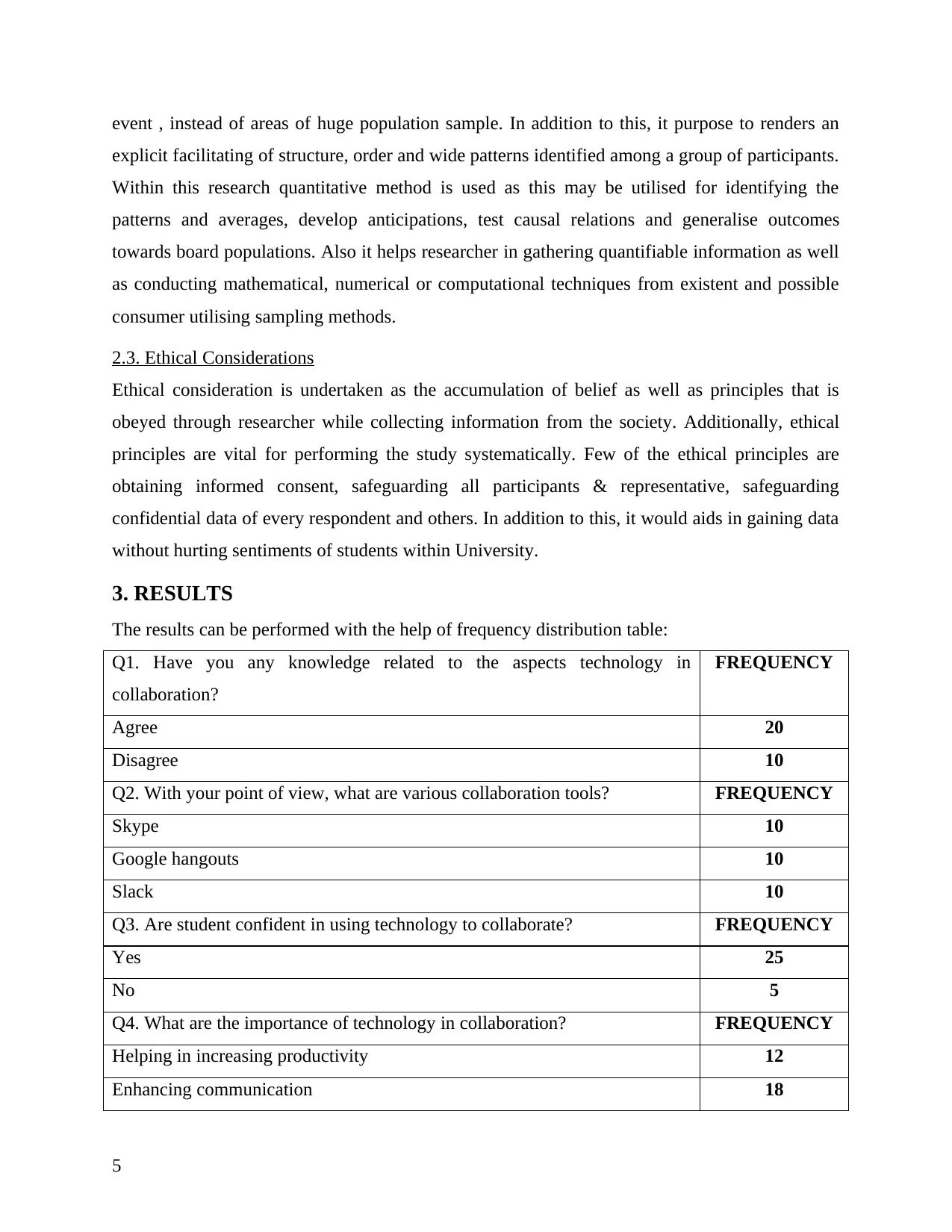
event , instead of areas of huge population sample. In addition to this, it purpose to renders an
explicit facilitating of structure, order and wide patterns identified among a group of participants.
Within this research quantitative method is used as this may be utilised for identifying the
patterns and averages, develop anticipations, test causal relations and generalise outcomes
towards board populations. Also it helps researcher in gathering quantifiable information as well
as conducting mathematical, numerical or computational techniques from existent and possible
consumer utilising sampling methods.
2.3. Ethical Considerations
Ethical consideration is undertaken as the accumulation of belief as well as principles that is
obeyed through researcher while collecting information from the society. Additionally, ethical
principles are vital for performing the study systematically. Few of the ethical principles are
obtaining informed consent, safeguarding all participants & representative, safeguarding
confidential data of every respondent and others. In addition to this, it would aids in gaining data
without hurting sentiments of students within University.
3. RESULTS
The results can be performed with the help of frequency distribution table:
Q1. Have you any knowledge related to the aspects technology in
collaboration?
FREQUENCY
Agree 20
Disagree 10
Q2. With your point of view, what are various collaboration tools? FREQUENCY
Skype 10
Google hangouts 10
Slack 10
Q3. Are student confident in using technology to collaborate? FREQUENCY
Yes 25
No 5
Q4. What are the importance of technology in collaboration? FREQUENCY
Helping in increasing productivity 12
Enhancing communication 18
5
explicit facilitating of structure, order and wide patterns identified among a group of participants.
Within this research quantitative method is used as this may be utilised for identifying the
patterns and averages, develop anticipations, test causal relations and generalise outcomes
towards board populations. Also it helps researcher in gathering quantifiable information as well
as conducting mathematical, numerical or computational techniques from existent and possible
consumer utilising sampling methods.
2.3. Ethical Considerations
Ethical consideration is undertaken as the accumulation of belief as well as principles that is
obeyed through researcher while collecting information from the society. Additionally, ethical
principles are vital for performing the study systematically. Few of the ethical principles are
obtaining informed consent, safeguarding all participants & representative, safeguarding
confidential data of every respondent and others. In addition to this, it would aids in gaining data
without hurting sentiments of students within University.
3. RESULTS
The results can be performed with the help of frequency distribution table:
Q1. Have you any knowledge related to the aspects technology in
collaboration?
FREQUENCY
Agree 20
Disagree 10
Q2. With your point of view, what are various collaboration tools? FREQUENCY
Skype 10
Google hangouts 10
Slack 10
Q3. Are student confident in using technology to collaborate? FREQUENCY
Yes 25
No 5
Q4. What are the importance of technology in collaboration? FREQUENCY
Helping in increasing productivity 12
Enhancing communication 18
5
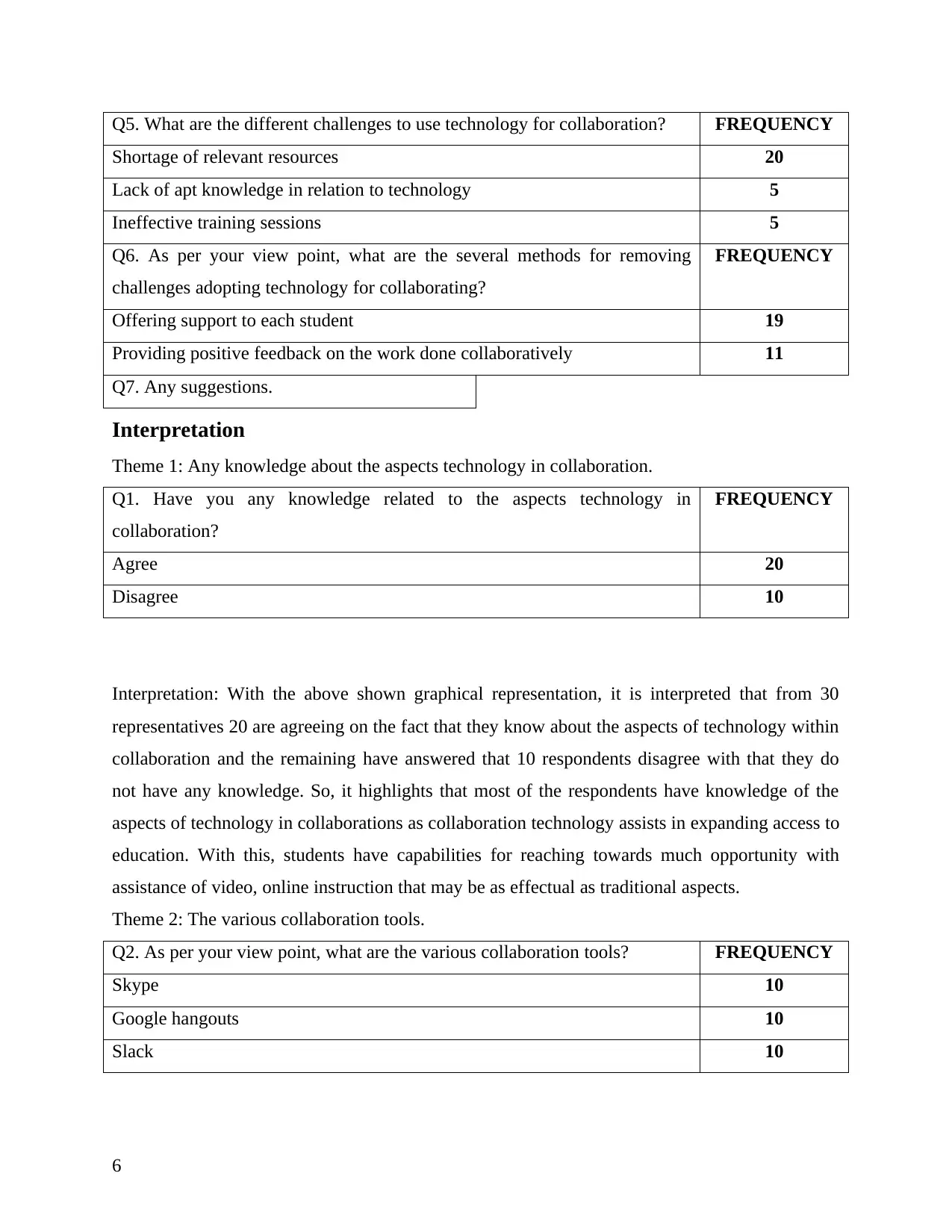
Q5. What are the different challenges to use technology for collaboration? FREQUENCY
Shortage of relevant resources 20
Lack of apt knowledge in relation to technology 5
Ineffective training sessions 5
Q6. As per your view point, what are the several methods for removing
challenges adopting technology for collaborating?
FREQUENCY
Offering support to each student 19
Providing positive feedback on the work done collaboratively 11
Q7. Any suggestions.
Interpretation
Theme 1: Any knowledge about the aspects technology in collaboration.
Q1. Have you any knowledge related to the aspects technology in
collaboration?
FREQUENCY
Agree 20
Disagree 10
Interpretation: With the above shown graphical representation, it is interpreted that from 30
representatives 20 are agreeing on the fact that they know about the aspects of technology within
collaboration and the remaining have answered that 10 respondents disagree with that they do
not have any knowledge. So, it highlights that most of the respondents have knowledge of the
aspects of technology in collaborations as collaboration technology assists in expanding access to
education. With this, students have capabilities for reaching towards much opportunity with
assistance of video, online instruction that may be as effectual as traditional aspects.
Theme 2: The various collaboration tools.
Q2. As per your view point, what are the various collaboration tools? FREQUENCY
Skype 10
Google hangouts 10
Slack 10
6
Shortage of relevant resources 20
Lack of apt knowledge in relation to technology 5
Ineffective training sessions 5
Q6. As per your view point, what are the several methods for removing
challenges adopting technology for collaborating?
FREQUENCY
Offering support to each student 19
Providing positive feedback on the work done collaboratively 11
Q7. Any suggestions.
Interpretation
Theme 1: Any knowledge about the aspects technology in collaboration.
Q1. Have you any knowledge related to the aspects technology in
collaboration?
FREQUENCY
Agree 20
Disagree 10
Interpretation: With the above shown graphical representation, it is interpreted that from 30
representatives 20 are agreeing on the fact that they know about the aspects of technology within
collaboration and the remaining have answered that 10 respondents disagree with that they do
not have any knowledge. So, it highlights that most of the respondents have knowledge of the
aspects of technology in collaborations as collaboration technology assists in expanding access to
education. With this, students have capabilities for reaching towards much opportunity with
assistance of video, online instruction that may be as effectual as traditional aspects.
Theme 2: The various collaboration tools.
Q2. As per your view point, what are the various collaboration tools? FREQUENCY
Skype 10
Google hangouts 10
Slack 10
6
⊘ This is a preview!⊘
Do you want full access?
Subscribe today to unlock all pages.

Trusted by 1+ million students worldwide
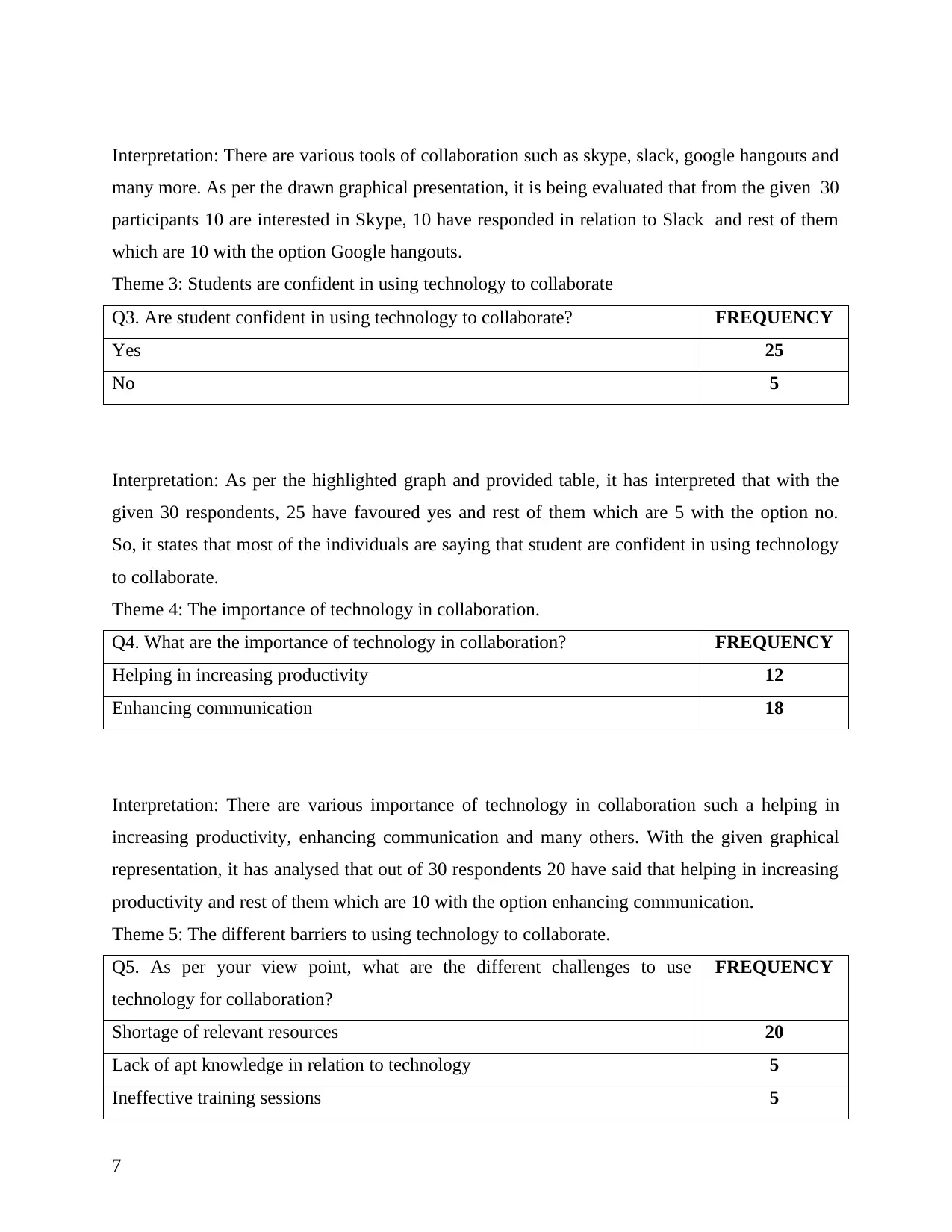
Interpretation: There are various tools of collaboration such as skype, slack, google hangouts and
many more. As per the drawn graphical presentation, it is being evaluated that from the given 30
participants 10 are interested in Skype, 10 have responded in relation to Slack and rest of them
which are 10 with the option Google hangouts.
Theme 3: Students are confident in using technology to collaborate
Q3. Are student confident in using technology to collaborate? FREQUENCY
Yes 25
No 5
Interpretation: As per the highlighted graph and provided table, it has interpreted that with the
given 30 respondents, 25 have favoured yes and rest of them which are 5 with the option no.
So, it states that most of the individuals are saying that student are confident in using technology
to collaborate.
Theme 4: The importance of technology in collaboration.
Q4. What are the importance of technology in collaboration? FREQUENCY
Helping in increasing productivity 12
Enhancing communication 18
Interpretation: There are various importance of technology in collaboration such a helping in
increasing productivity, enhancing communication and many others. With the given graphical
representation, it has analysed that out of 30 respondents 20 have said that helping in increasing
productivity and rest of them which are 10 with the option enhancing communication.
Theme 5: The different barriers to using technology to collaborate.
Q5. As per your view point, what are the different challenges to use
technology for collaboration?
FREQUENCY
Shortage of relevant resources 20
Lack of apt knowledge in relation to technology 5
Ineffective training sessions 5
7
many more. As per the drawn graphical presentation, it is being evaluated that from the given 30
participants 10 are interested in Skype, 10 have responded in relation to Slack and rest of them
which are 10 with the option Google hangouts.
Theme 3: Students are confident in using technology to collaborate
Q3. Are student confident in using technology to collaborate? FREQUENCY
Yes 25
No 5
Interpretation: As per the highlighted graph and provided table, it has interpreted that with the
given 30 respondents, 25 have favoured yes and rest of them which are 5 with the option no.
So, it states that most of the individuals are saying that student are confident in using technology
to collaborate.
Theme 4: The importance of technology in collaboration.
Q4. What are the importance of technology in collaboration? FREQUENCY
Helping in increasing productivity 12
Enhancing communication 18
Interpretation: There are various importance of technology in collaboration such a helping in
increasing productivity, enhancing communication and many others. With the given graphical
representation, it has analysed that out of 30 respondents 20 have said that helping in increasing
productivity and rest of them which are 10 with the option enhancing communication.
Theme 5: The different barriers to using technology to collaborate.
Q5. As per your view point, what are the different challenges to use
technology for collaboration?
FREQUENCY
Shortage of relevant resources 20
Lack of apt knowledge in relation to technology 5
Ineffective training sessions 5
7
Paraphrase This Document
Need a fresh take? Get an instant paraphrase of this document with our AI Paraphraser
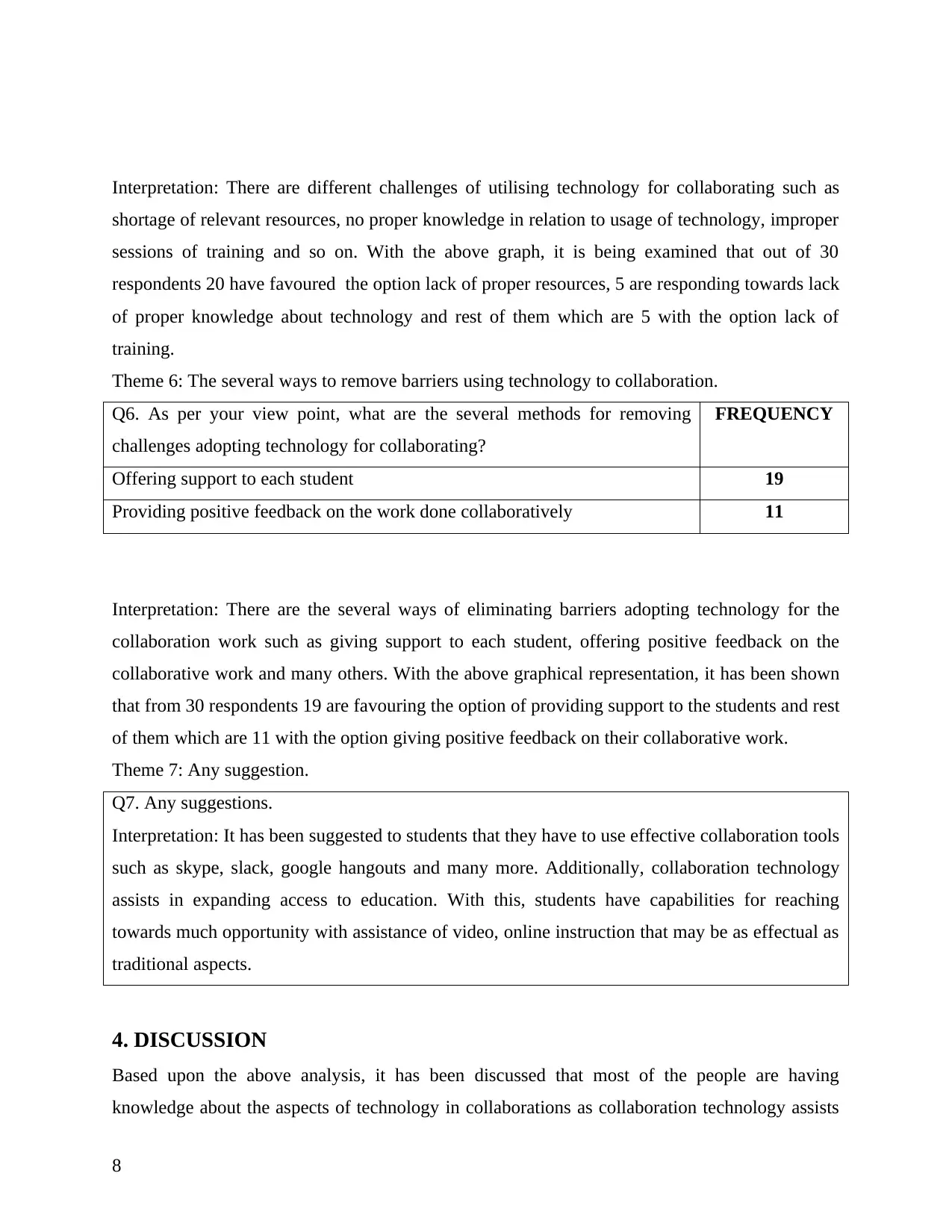
Interpretation: There are different challenges of utilising technology for collaborating such as
shortage of relevant resources, no proper knowledge in relation to usage of technology, improper
sessions of training and so on. With the above graph, it is being examined that out of 30
respondents 20 have favoured the option lack of proper resources, 5 are responding towards lack
of proper knowledge about technology and rest of them which are 5 with the option lack of
training.
Theme 6: The several ways to remove barriers using technology to collaboration.
Q6. As per your view point, what are the several methods for removing
challenges adopting technology for collaborating?
FREQUENCY
Offering support to each student 19
Providing positive feedback on the work done collaboratively 11
Interpretation: There are the several ways of eliminating barriers adopting technology for the
collaboration work such as giving support to each student, offering positive feedback on the
collaborative work and many others. With the above graphical representation, it has been shown
that from 30 respondents 19 are favouring the option of providing support to the students and rest
of them which are 11 with the option giving positive feedback on their collaborative work.
Theme 7: Any suggestion.
Q7. Any suggestions.
Interpretation: It has been suggested to students that they have to use effective collaboration tools
such as skype, slack, google hangouts and many more. Additionally, collaboration technology
assists in expanding access to education. With this, students have capabilities for reaching
towards much opportunity with assistance of video, online instruction that may be as effectual as
traditional aspects.
4. DISCUSSION
Based upon the above analysis, it has been discussed that most of the people are having
knowledge about the aspects of technology in collaborations as collaboration technology assists
8
shortage of relevant resources, no proper knowledge in relation to usage of technology, improper
sessions of training and so on. With the above graph, it is being examined that out of 30
respondents 20 have favoured the option lack of proper resources, 5 are responding towards lack
of proper knowledge about technology and rest of them which are 5 with the option lack of
training.
Theme 6: The several ways to remove barriers using technology to collaboration.
Q6. As per your view point, what are the several methods for removing
challenges adopting technology for collaborating?
FREQUENCY
Offering support to each student 19
Providing positive feedback on the work done collaboratively 11
Interpretation: There are the several ways of eliminating barriers adopting technology for the
collaboration work such as giving support to each student, offering positive feedback on the
collaborative work and many others. With the above graphical representation, it has been shown
that from 30 respondents 19 are favouring the option of providing support to the students and rest
of them which are 11 with the option giving positive feedback on their collaborative work.
Theme 7: Any suggestion.
Q7. Any suggestions.
Interpretation: It has been suggested to students that they have to use effective collaboration tools
such as skype, slack, google hangouts and many more. Additionally, collaboration technology
assists in expanding access to education. With this, students have capabilities for reaching
towards much opportunity with assistance of video, online instruction that may be as effectual as
traditional aspects.
4. DISCUSSION
Based upon the above analysis, it has been discussed that most of the people are having
knowledge about the aspects of technology in collaborations as collaboration technology assists
8
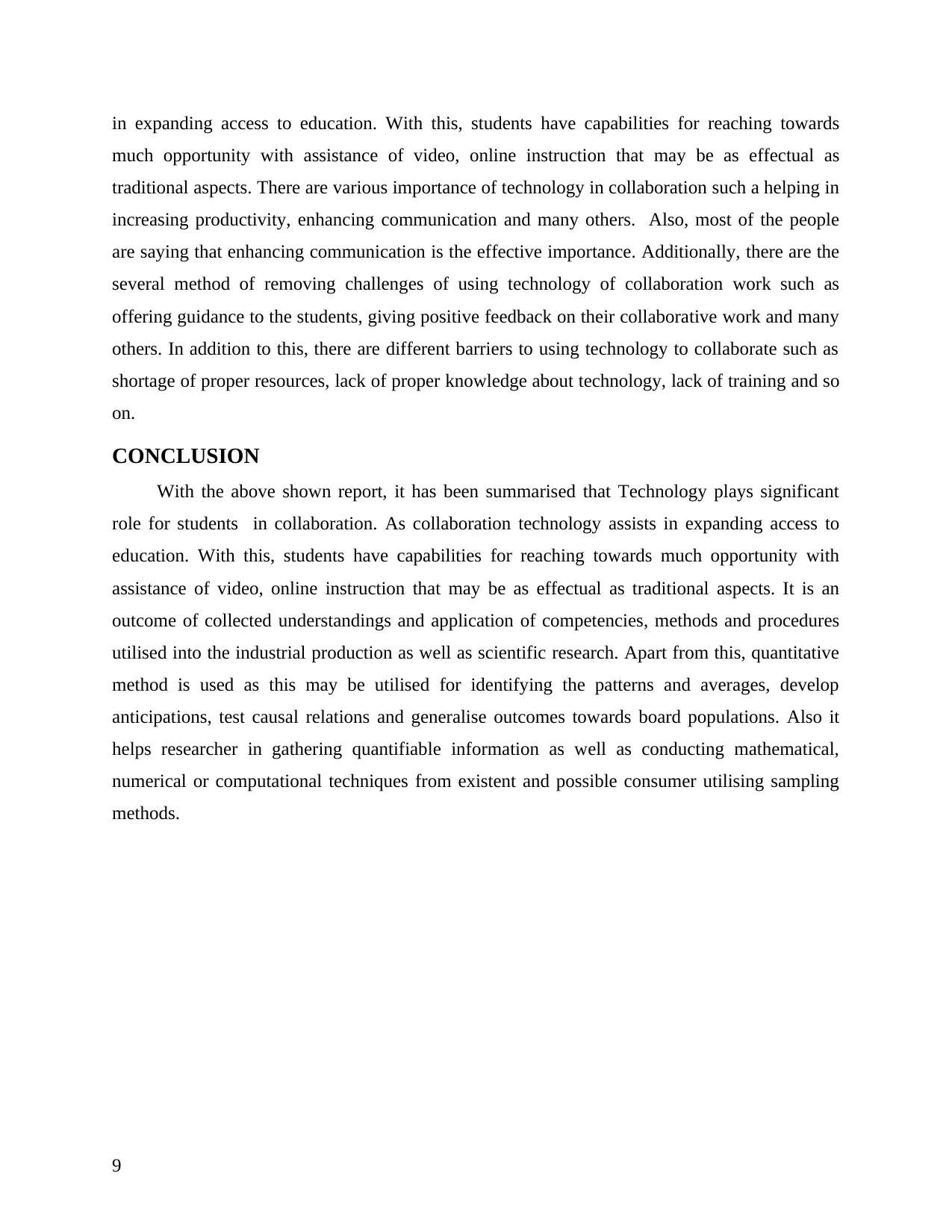
in expanding access to education. With this, students have capabilities for reaching towards
much opportunity with assistance of video, online instruction that may be as effectual as
traditional aspects. There are various importance of technology in collaboration such a helping in
increasing productivity, enhancing communication and many others. Also, most of the people
are saying that enhancing communication is the effective importance. Additionally, there are the
several method of removing challenges of using technology of collaboration work such as
offering guidance to the students, giving positive feedback on their collaborative work and many
others. In addition to this, there are different barriers to using technology to collaborate such as
shortage of proper resources, lack of proper knowledge about technology, lack of training and so
on.
CONCLUSION
With the above shown report, it has been summarised that Technology plays significant
role for students in collaboration. As collaboration technology assists in expanding access to
education. With this, students have capabilities for reaching towards much opportunity with
assistance of video, online instruction that may be as effectual as traditional aspects. It is an
outcome of collected understandings and application of competencies, methods and procedures
utilised into the industrial production as well as scientific research. Apart from this, quantitative
method is used as this may be utilised for identifying the patterns and averages, develop
anticipations, test causal relations and generalise outcomes towards board populations. Also it
helps researcher in gathering quantifiable information as well as conducting mathematical,
numerical or computational techniques from existent and possible consumer utilising sampling
methods.
9
much opportunity with assistance of video, online instruction that may be as effectual as
traditional aspects. There are various importance of technology in collaboration such a helping in
increasing productivity, enhancing communication and many others. Also, most of the people
are saying that enhancing communication is the effective importance. Additionally, there are the
several method of removing challenges of using technology of collaboration work such as
offering guidance to the students, giving positive feedback on their collaborative work and many
others. In addition to this, there are different barriers to using technology to collaborate such as
shortage of proper resources, lack of proper knowledge about technology, lack of training and so
on.
CONCLUSION
With the above shown report, it has been summarised that Technology plays significant
role for students in collaboration. As collaboration technology assists in expanding access to
education. With this, students have capabilities for reaching towards much opportunity with
assistance of video, online instruction that may be as effectual as traditional aspects. It is an
outcome of collected understandings and application of competencies, methods and procedures
utilised into the industrial production as well as scientific research. Apart from this, quantitative
method is used as this may be utilised for identifying the patterns and averages, develop
anticipations, test causal relations and generalise outcomes towards board populations. Also it
helps researcher in gathering quantifiable information as well as conducting mathematical,
numerical or computational techniques from existent and possible consumer utilising sampling
methods.
9
⊘ This is a preview!⊘
Do you want full access?
Subscribe today to unlock all pages.

Trusted by 1+ million students worldwide
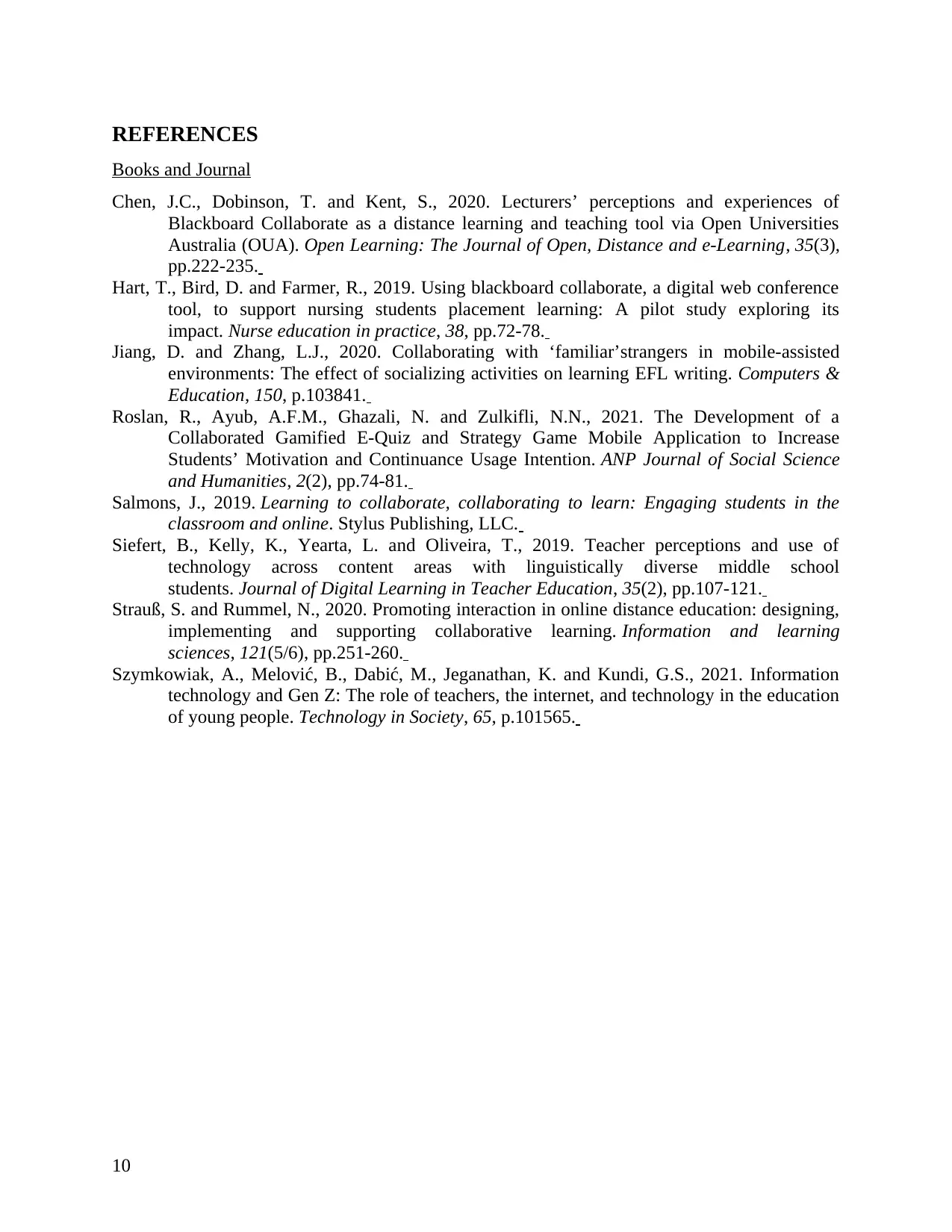
REFERENCES
Books and Journal
Chen, J.C., Dobinson, T. and Kent, S., 2020. Lecturers’ perceptions and experiences of
Blackboard Collaborate as a distance learning and teaching tool via Open Universities
Australia (OUA). Open Learning: The Journal of Open, Distance and e-Learning, 35(3),
pp.222-235.
Hart, T., Bird, D. and Farmer, R., 2019. Using blackboard collaborate, a digital web conference
tool, to support nursing students placement learning: A pilot study exploring its
impact. Nurse education in practice, 38, pp.72-78.
Jiang, D. and Zhang, L.J., 2020. Collaborating with ‘familiar’strangers in mobile-assisted
environments: The effect of socializing activities on learning EFL writing. Computers &
Education, 150, p.103841.
Roslan, R., Ayub, A.F.M., Ghazali, N. and Zulkifli, N.N., 2021. The Development of a
Collaborated Gamified E-Quiz and Strategy Game Mobile Application to Increase
Students’ Motivation and Continuance Usage Intention. ANP Journal of Social Science
and Humanities, 2(2), pp.74-81.
Salmons, J., 2019. Learning to collaborate, collaborating to learn: Engaging students in the
classroom and online. Stylus Publishing, LLC.
Siefert, B., Kelly, K., Yearta, L. and Oliveira, T., 2019. Teacher perceptions and use of
technology across content areas with linguistically diverse middle school
students. Journal of Digital Learning in Teacher Education, 35(2), pp.107-121.
Strauß, S. and Rummel, N., 2020. Promoting interaction in online distance education: designing,
implementing and supporting collaborative learning. Information and learning
sciences, 121(5/6), pp.251-260.
Szymkowiak, A., Melović, B., Dabić, M., Jeganathan, K. and Kundi, G.S., 2021. Information
technology and Gen Z: The role of teachers, the internet, and technology in the education
of young people. Technology in Society, 65, p.101565.
10
Books and Journal
Chen, J.C., Dobinson, T. and Kent, S., 2020. Lecturers’ perceptions and experiences of
Blackboard Collaborate as a distance learning and teaching tool via Open Universities
Australia (OUA). Open Learning: The Journal of Open, Distance and e-Learning, 35(3),
pp.222-235.
Hart, T., Bird, D. and Farmer, R., 2019. Using blackboard collaborate, a digital web conference
tool, to support nursing students placement learning: A pilot study exploring its
impact. Nurse education in practice, 38, pp.72-78.
Jiang, D. and Zhang, L.J., 2020. Collaborating with ‘familiar’strangers in mobile-assisted
environments: The effect of socializing activities on learning EFL writing. Computers &
Education, 150, p.103841.
Roslan, R., Ayub, A.F.M., Ghazali, N. and Zulkifli, N.N., 2021. The Development of a
Collaborated Gamified E-Quiz and Strategy Game Mobile Application to Increase
Students’ Motivation and Continuance Usage Intention. ANP Journal of Social Science
and Humanities, 2(2), pp.74-81.
Salmons, J., 2019. Learning to collaborate, collaborating to learn: Engaging students in the
classroom and online. Stylus Publishing, LLC.
Siefert, B., Kelly, K., Yearta, L. and Oliveira, T., 2019. Teacher perceptions and use of
technology across content areas with linguistically diverse middle school
students. Journal of Digital Learning in Teacher Education, 35(2), pp.107-121.
Strauß, S. and Rummel, N., 2020. Promoting interaction in online distance education: designing,
implementing and supporting collaborative learning. Information and learning
sciences, 121(5/6), pp.251-260.
Szymkowiak, A., Melović, B., Dabić, M., Jeganathan, K. and Kundi, G.S., 2021. Information
technology and Gen Z: The role of teachers, the internet, and technology in the education
of young people. Technology in Society, 65, p.101565.
10
Paraphrase This Document
Need a fresh take? Get an instant paraphrase of this document with our AI Paraphraser
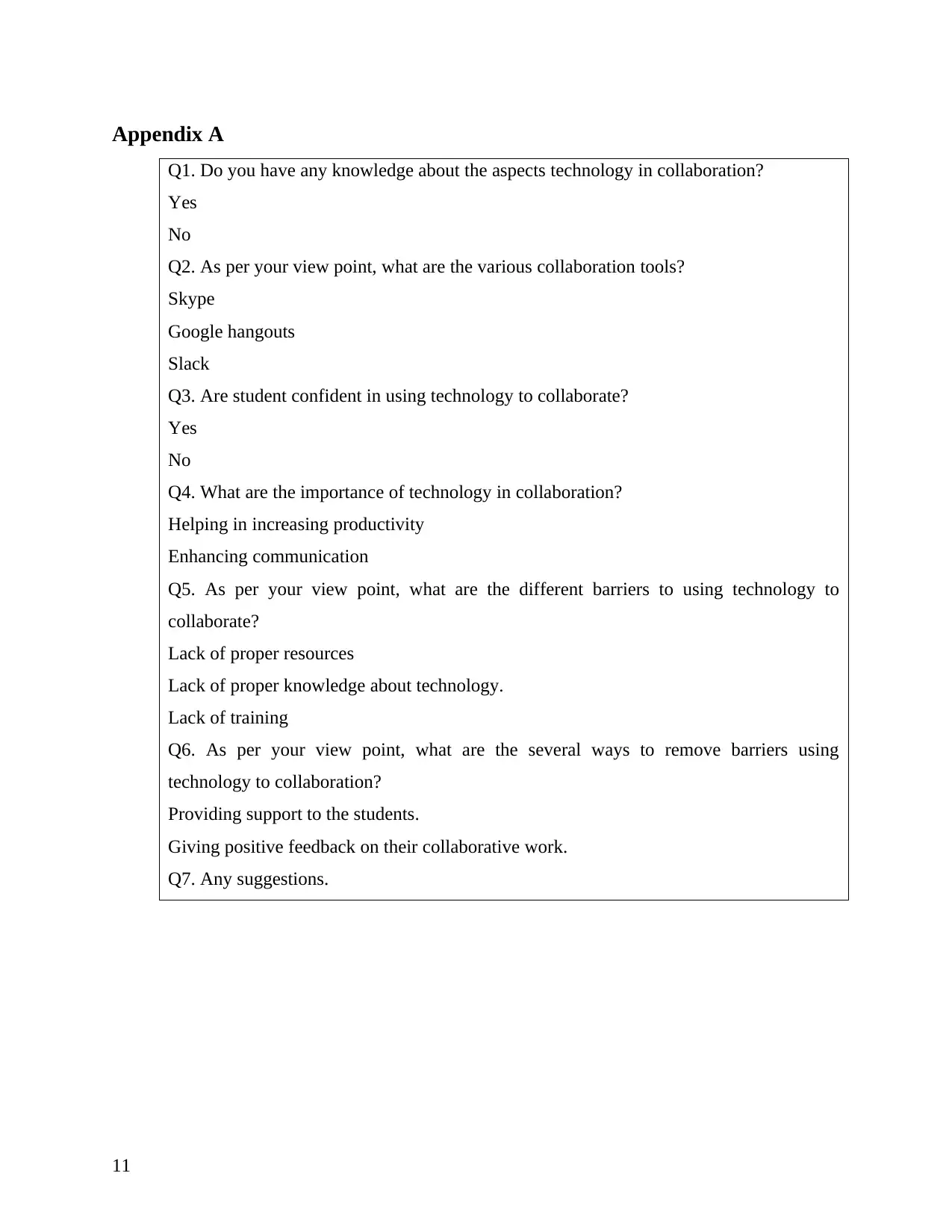
Appendix A
Q1. Do you have any knowledge about the aspects technology in collaboration?
Yes
No
Q2. As per your view point, what are the various collaboration tools?
Skype
Google hangouts
Slack
Q3. Are student confident in using technology to collaborate?
Yes
No
Q4. What are the importance of technology in collaboration?
Helping in increasing productivity
Enhancing communication
Q5. As per your view point, what are the different barriers to using technology to
collaborate?
Lack of proper resources
Lack of proper knowledge about technology.
Lack of training
Q6. As per your view point, what are the several ways to remove barriers using
technology to collaboration?
Providing support to the students.
Giving positive feedback on their collaborative work.
Q7. Any suggestions.
11
Q1. Do you have any knowledge about the aspects technology in collaboration?
Yes
No
Q2. As per your view point, what are the various collaboration tools?
Skype
Google hangouts
Slack
Q3. Are student confident in using technology to collaborate?
Yes
No
Q4. What are the importance of technology in collaboration?
Helping in increasing productivity
Enhancing communication
Q5. As per your view point, what are the different barriers to using technology to
collaborate?
Lack of proper resources
Lack of proper knowledge about technology.
Lack of training
Q6. As per your view point, what are the several ways to remove barriers using
technology to collaboration?
Providing support to the students.
Giving positive feedback on their collaborative work.
Q7. Any suggestions.
11
1 out of 11
Related Documents
Your All-in-One AI-Powered Toolkit for Academic Success.
+13062052269
info@desklib.com
Available 24*7 on WhatsApp / Email
![[object Object]](/_next/static/media/star-bottom.7253800d.svg)
Unlock your academic potential
Copyright © 2020–2025 A2Z Services. All Rights Reserved. Developed and managed by ZUCOL.


